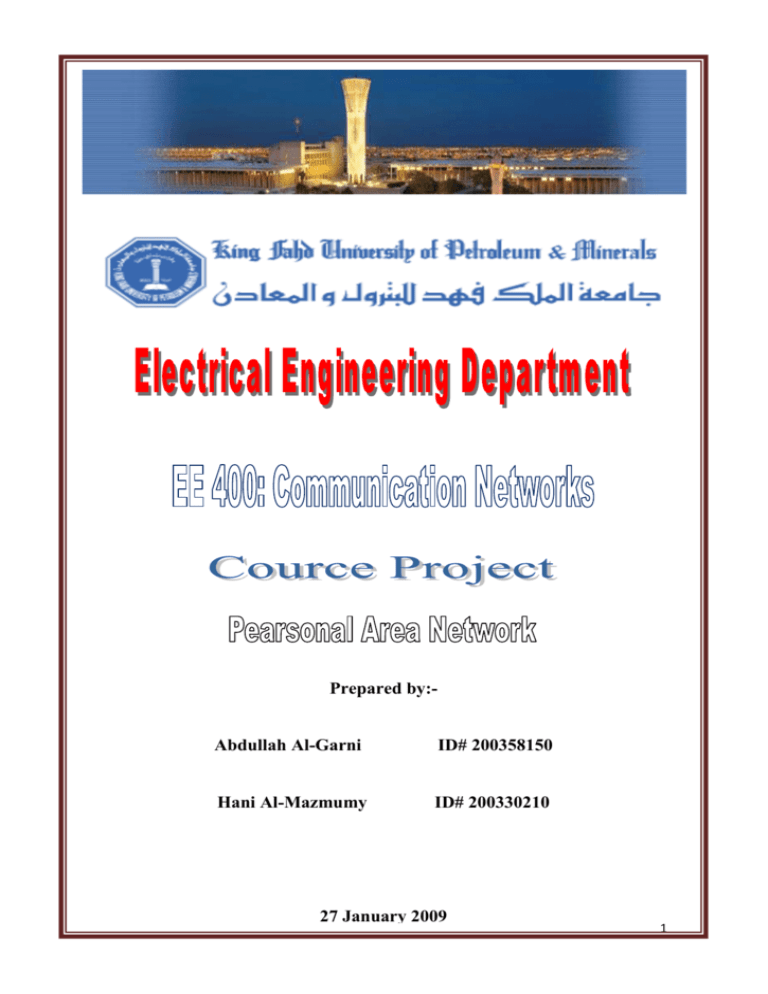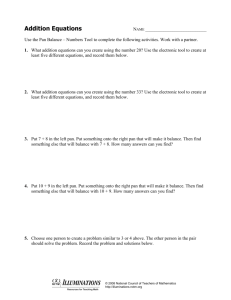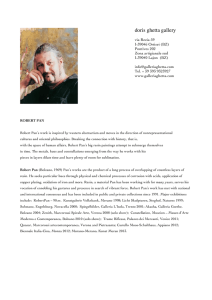PAN2 - Faculty Personal Homepage
advertisement

Prepared by:- Abdullah Al-Garni ID# 200358150 Hani Al-Mazmumy ID# 200330210 27 January 2009 1 TABLE OF CONTENTS LIST OF FIGURES ……………………………………………… 3 LIST OF TABLES .………………………………………………. 3 I. II. INTRODUCTION……………………………………. 4 PHYSICAL AND DATA LINK LAYERS…………… 5 A. IEEE 802.15.1 B. IEEE 802.15.3 III. NETWORK LAYER ARCHECTURE………………. 8 A. SCENARIOS AND MOTIVATIONS B. EXISTING SOLUTION C. THE PAN ARCHITECTURE D. NETWORK LAYER ARCHITECTURE FOR PAN IV. NETWORK LAYER ISSUSES……………………… 12 A. PAN ORGANIZATION B. PAN ADDRESSING AND ROUTING V. CONCLUSION……………………………………… 13 REFERENCES 2 LIST OF FIGURES Figure 1: Personal area network (PAN) Figure 2: Virtual Home Truck. Figure 3: The Three Layers PAN Architecture. LIST OF TABLES Table 1: Bluetooth Data Rates 3 I. INTRODUCTION A Personal Area Network (PAN) is a small network that covers only a personal work space, e.g. an office or a meeting room. Typically, PANs can be defined in terms of distance. the term PAN exclusively refers to network using communications, both radio and optical, and is usually considered to have a range of 10 meters these networks are small in size, belong to a single person so they are limited to his or her environment within a small area like his room, body or garden etc. These networks involves handheld personal computers, cell phone, a mobile computer, laptop, PC’s, printers and personal digital assistants PDAs to communicate with each other over short distances either wired or wireless. General features of PANs are low power consumption, low data rate, low cost and small package size. Of course, however, there are very high-rate systems for PANs such as Ultra-Wideband (UWB). Figure1: Personal area network (PAN) [2] 4 The use of a PAN can be divided into either lower date rate systems such as mobile phone for access to larger systems or high rate data systems such as household video or audio distribution. PANs can be implemented with cables or wirelessly. USB and FireWire technologies, which are wired with computer buses, are examples of wired personal area network. On the other hand, a wireless personal area network (WPAN) can also be made with network technologies such as Bluetooth and Zigbee. II. PHYSICAL AND DATA LINK LAYERS The PAN has many technologies defined by Institute of Electrical and Electronics and Engineers (IEEE) and given certain standards. These standards are concerned with physical and data link layers specifications in Open System Interconnection (OSI) protocol. A. IEEE 802.15.1 This standard is a WPAN technology and known as Bluetooth. This technology operates over 2.402 – 2.480 GHz industrial, scientific and medical (ISM) band. Its coverage depends on the output power. In Class 1, the output power is up to 20 dBm and can reach 100m. Whereas in Class 2, the maximum output power is 4 dBm and the 5 coverage is 10m. The short range is 10 cm which is in Class 3 because the maximum output power is 0 dBm. Bluetooth has different data rates as shown in table 1. Bluetooth version 1.2 and older 2.0 and 2.1 Asynchronous data connection Asynchronous data connection Asymmetric Asymmetric feature Symmetric 57.6 kbps Upstream 172.8 kbps 433.9 kbps Downstream Symmetric 433.9 kbps 1.3 Mbps 2.169 Mbps Table1: Bluetooth Data Rates Frequency Hopping Spread Spectrum (FHSS) is used to allow multiple accesses to access at same time. ISM band can serve 79 nonoverlapping channels at a time with 1 MHz channel spacing. 1 MHz and 3 MHz are inserted at the beginning and the end of ISM band, respectively. The topology of the Bluetooth is a star with one master and up to seven slaves. These eight users are called piconet. The data can be only transmitted in one way between the mater and one slave. A group of piconets can connect together to form a scatternet. In a scatternet, one piconet works as a master and the others work as slaves. Bluetooth represents the 1 and 0 by a positive and a negative frequency deviation, respectively, using Gaussian Frequency Shift Keying (GFSK) modulation. 6 B. IEEE 802.15.3 This standard is a WPAN technology and known as High-Rate WPAN (HR WPAN). This technology operates over 2.402 – 2.480 GHz ISM band. Its coverage can reach up to 10 m. HR WPAN uses two different modulation schemes which are Quadrature Phase Shift Keying (QPSK) and Quadrature Amplitude Modulation (QAM). These schemes based on Trellis Coded Modulation (TCM). QPSK has two types which are Differential QPSK (DPSK). QPSK uses 8-state TCM with data rate of 11 Mbps, while DQPSK has data rate of 22 Mbps. The second scheme is based on 8-state TCM and has three types which are 16-QAM, 32-QAM and 64-QAM with data rates of 33, 44 and 55 Mbps, respectively. 7 III. NETWORK LAYER ARCHECTURE In order to give the end user a homogeneous and a clear view of different technology, it should be bridged by network layer architecture which is considered in this case as the core part to an excellent and successful PN realization. All devices in the home, car and in the office must be included by PN in addition to the person’s wearable and wireless and since the PN addresses all communication needs, it leads to an integration of these devices and other networks into one PN and communicates with existing networks like infrastructure networks and other networks [3]. A. SCENARIOS AND MOTIVATIONS. Suppose network, client that there network, are technologies company network which and include truck home which is equipped with internet access, a mobile phone, headset etc after finishing the work, the internet connection at home is set up by a truck driver. On the other hand, there is a cluster of cooperating devices such as camera and speaker at home. The existing devices provide the driver with virtual home environment and through them he can virtually seeing his family and talking to them. Figure 3.1 shows the scenarios [4]. 8 Figure 2: Virtual Home Truck. [4] At a client, the driver’s PAN connects him to the client’s company network and downloads the documents. Although there are some technologies which make partial solution to this scenarios, all these technologies needs to be combined into something easy for user to handle. Moreover, the user needs instant access to services and communications. Eventually, the target of PN includes the following points: First, The PN need to be easy for use. Second, setup and configure. Finally, maintain, fast and secure [4]. B. EXISTING SOLUTION. There are proposal solutions that try to meet person’s communication needs. One of these solutions is Personal Distribution Environment (PDE) which is defined by the mobile VCE. It is similar PN but it does not have clear network architecture yet. 9 Moreover, the concept which is called Personal Mobile Gateway (PMG) is another solution offered by IXI Mobile. It carries the idea of a mobile phone with a WPAN technology. The PMG enabled mobile phone can be used to connect to the infrastructure. In addition, the PMG enabled devices can communicate with each other [4]. Another solution provided by the University of Illinois at Urbana Champaign and the Mobius is called Mobile Grouped devices (MOPEDs).Each MOPED is connected to a proxy via an infrastructure connection. Because of the dependence of MOPED on the proxy and the infrastructure it is not suitable for PN. The MOPED is too limited to support the PN since it does not address direct ad-hoc communication with other person’s MOPEMs [3]. C. THE PAN ARCHITECTURE There are some projects proposed architecture for PAN. One of these is the IST MAGNET project. In this project, the PN architecture is composed of three planes (figure 4): 1-The link layer plane 2-The network plane 3-The service plane Figure 3: The Three Layers PAN Architecture. [4] 10 The link layer plane is composed of various wired and wireless link layer technology including infrastructure links. In this layer any two node can be implemented by the same technology in order to communicate within the radio range. For any two nodes within the PAN need to communicate, a network plane needed. The network plane divides the nodes within the network into two different nodes: personal and foreign based on a certain person owns the node or not. Moreover, clusters are formed by personal nodes communicate with other clusters via infrastructure. The third plane which is the highest plane in this architecture is the service plane. The service provided by this plane is divided into public and private services. The private services are restricted to the owner or trusted persons via architecture and access control [3][4]. D. A NETWORK LAYER ARCHITECTURE FOR PAN In order to support the future and current wireless communication the network layer need to be independent as possible from the underlying link layer. For this case, the internet IP was designed in order to meet this requirement and consequently, IP is the proposed packet format as well as wireless communication. The selection of IP also makes it easier to connect the wireless with internet which will be important for the future [4]. The main idea of this layer is to separate communication between nodes of the same user from communication of other nodes. Nodes which 11 belong to the same user from clusters of personal nodes which can communicate with any other personal node in that cluster without using intermediate nodes not used by the same person. The ownership is realized through a personal identifier that the owner uploads to all this services and so the communication routing and other self organizing mechanism can be protected on a local scale. For the global scale tunnels are established between the clusters to both accommodate and protect inter cluster communicate [3]. IV. NETWORK LAYER ISSUSES A. PAN ORGANIZATION There are three requirements need to be fulfilled in order to form a PAN and realize inter cluster communication. First, the cluster needs to have access to the fixed infrastructure through Gateway. Secondly, when the access is available the clusters need to be capable of finding each other in order to establish tunnel between them. Thirdly, once the PAN has been formed, it should be able to maintain itself although of changes in gateway or node mobility [4]. B. PAN ADDRESSING AND ROUTING The intra PN communication happens when the PN has been formed. The PN local resource and service discovery solution allows the personal nodes to know about the services and devices in the PN. On the other hand, in order to create connectivity among these services and devices. Addressing 12 and routing are indispensable. Most of the links in the PAN ad hoc network are wireless, some are wired and some are tunnel among the clusters [4]. V. CONCLUSION As discussed in the previous pages the personal area network has many applications. Anyone can build his own personal network and there is no license. It is easy to build and it can improve our daily life. In near future, many applications will be based on this network system such as office and home devices. 13 REFERENCES [1] Byung-Seo, Yuguang, et al. “Rate-Adaptive MAC Protocol in High-Rate Personal Area Networks”. 2004: 1394- 1399.<http://ieeexplore.ieee.org/stamp/stamp.jsp?arnumber= 01311646> [2] Srikanth, H. “Self-Study Report on Personal Area Networks”. 2007.< http:/ /www.ece .osu.edu/~harihars/report.pdf > [3] IST MAGNET. <http://www.ist-magnet.org/> [4] Martin, ajeroen, et al. “A Network Layer Architecture for Personal Networks”. 2005. <http://www.wmc.ewi.tudelft.nl/~martin/docs/ ShanghaiWS2004-Jacobsson.pdf> 14






